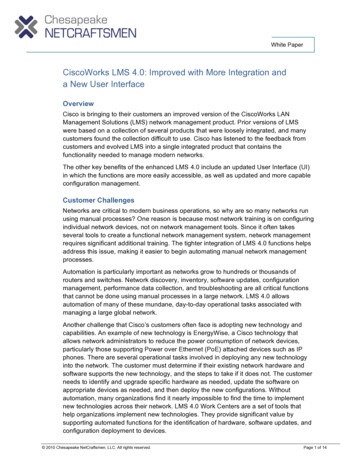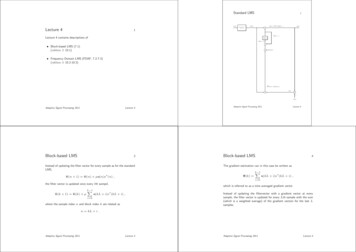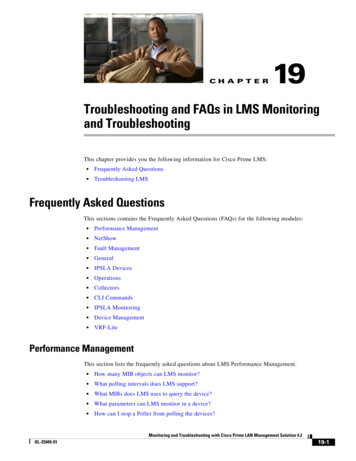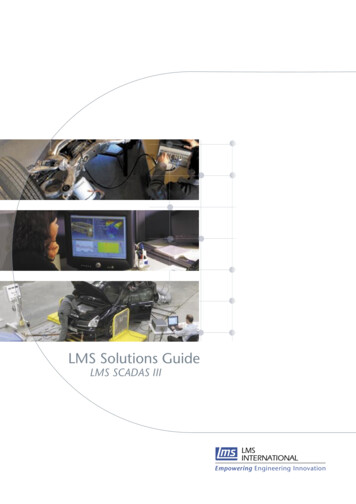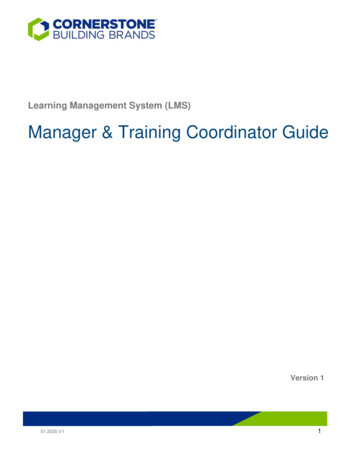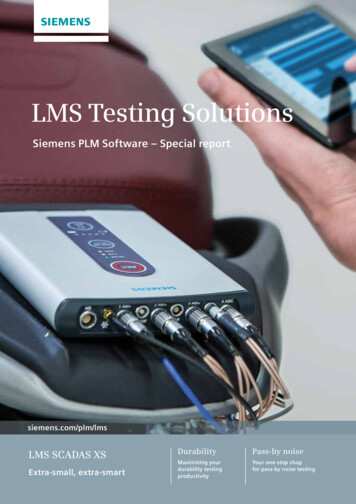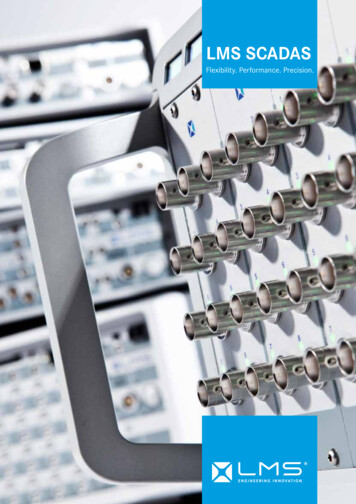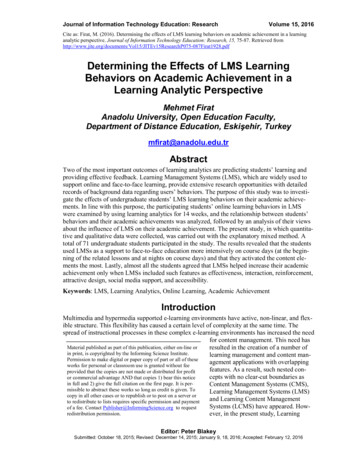
Transcription
Journal of Information Technology Education: ResearchVolume 15, 2016Cite as: Firat, M. (2016). Determining the effects of LMS learning behaviors on academic achievement in a learninganalytic perspective. Journal of Information Technology Education: Research, 15, 75-87. Retrieved earchP075-087Firat1928.pdfDetermining the Effects of LMS LearningBehaviors on Academic Achievement in aLearning Analytic PerspectiveMehmet FiratAnadolu University, Open Education Faculty,Department of Distance Education, Eskişehir, Turkeymfirat@anadolu.edu.trAbstractTwo of the most important outcomes of learning analytics are predicting students’ learning andproviding effective feedback. Learning Management Systems (LMS), which are widely used tosupport online and face-to-face learning, provide extensive research opportunities with detailedrecords of background data regarding users’ behaviors. The purpose of this study was to investigate the effects of undergraduate students’ LMS learning behaviors on their academic achievements. In line with this purpose, the participating students’ online learning behaviors in LMSwere examined by using learning analytics for 14 weeks, and the relationship between students’behaviors and their academic achievements was analyzed, followed by an analysis of their viewsabout the influence of LMS on their academic achievement. The present study, in which quantitative and qualitative data were collected, was carried out with the explanatory mixed method. Atotal of 71 undergraduate students participated in the study. The results revealed that the studentsused LMSs as a support to face-to-face education more intensively on course days (at the beginning of the related lessons and at nights on course days) and that they activated the content elements the most. Lastly, almost all the students agreed that LMSs helped increase their academicachievement only when LMSs included such features as effectiveness, interaction, reinforcement,attractive design, social media support, and accessibility.Keywords: LMS, Learning Analytics, Online Learning, Academic AchievementIntroductionMultimedia and hypermedia supported e-learning environments have active, non-linear, and flexible structure. This flexibility has caused a certain level of complexity at the same time. Thespread of instructional processes in these complex e-learning environments has increased the needfor content management. This need hasMaterial published as part of this publication, either on-line orresulted in the creation of a number ofin print, is copyrighted by the Informing Science Institute.learning management and content manPermission to make digital or paper copy of part or all of theseagement applications with overlappingworks for personal or classroom use is granted without feefeatures. As a result, such nested conprovided that the copies are not made or distributed for profitcepts with no clear-cut boundaries asor commercial advantage AND that copies 1) bear this noticein full and 2) give the full citation on the first page. It is perContent Management Systems (CMS),missible to abstract these works so long as credit is given. ToLearning Management Systems (LMS)copy in all other cases or to republish or to post on a server orand Learning Content Managementto redistribute to lists requires specific permission and paymentSystems (LCMS) have appeared. Howof a fee. Contact Publisher@InformingScience.org to requestredistribution permission.ever, in the present study, LearningEditor: Peter BlakeySubmitted: October 18, 2015; Revised: December 14, 2015; January 9, 18, 2016; Accepted: February 12, 2016
Effects of LMS Learning Behaviors on Academic AchievementManagement System (LMS), considered to be a more comprehensive concept, is used as an umbrella concept. Learning management systems (LMS) have been proven to encourage a constructive approach to knowledge acquisition and to support active learning (Emelyanova & Voronina,2014).In the last years, learning platforms like Edmodo (Holland & Muilenburg, 2011), MOOC platforms like EdX and Coursera (Breslow, Pritchard, DeBoer, Stump, Ho, & Seaton, 2013) andcloud file hosting services like Google Drive and DropBox (Stantchev, Colomo-Palacios, SotoAcosta ,& Misra, 2014) have become very popular. Similarly, the number of educational mobileapplications has been rapidly increasing. The increasing number of Internet-based learning platforms has led to a decreased use of package platforms like CMS and LMS. In addition, CMSs andLMSs, which are still widely used, include Adobe Connect, Blackboard, WebCT and Moodle.Use of LMS provides students and lecturers with a set of tools to improve the learning processand its management (Stantchev et al., 2014). According to Emelyanova and Voronina (2014), as agroup of consistent users, teacher and student perceptions of LMS could help determine the probable problems with LMS and create productive learning environments. However, there are limitedresearch in related literature which examine the effects of learner behaviors in LMSs on theiracademic achievement.Learning Analytics of LMSThe use of electronic environments and tools in scientific studies has always been limited to suchpackage programs as online questionnaires, e-mails, SPSS, Nvivo ,and LISREL because the collection, interpretation, evaluation, and visualization of electronic data records required specialization until a few years ago. However, today, with the help of various graphs, tables, and other visuals these data can be easily processed and used by students, teachers and analysts (Shum, Knight& Littleton, 2012).Learning analytics is an emerging and promising field for IT-supported learning (Conde & Hernández-García, 2015). Learning analytics is defined as an area which focuses on reaching patternsor tendencies via data sets related to students or via large sets of educational data to maintain thedevelopment of supplementary and personalized higher education systems (Johnson, AdamsBecker, Estrada, & Freeman, 2014). Learning analytics is defined by Agudo-Peregrina, IglesiasPradas, Conde-González, and Hernández-García, (2014) as the analysis of electronic learningdata allowing teachers, course designers and virtual learning environment administrators to investigate the unobservable patterns and the information underlying the learning process. Accordingto another definition, learning analytics is defined as a developing field in which advanced dataanalysis tools are used to improve learning and education (Elias, 2011). Lastly, Siemens (2013)defines learning analytics as a new discipline which involves the measurement, collection, analysis, and reporting of data regarding learners and learning contexts to understand and improve thelearning itself and the environments in which learning occurs.The analysis dashboards of Content Management Systems (CMS) and Learning ManagementSystems (LMS) like Blackboard, Moodle, Edmodo and ConnectEdu are among the major environments in which effective research can be conducted in the field of learning analytics. In LMSsystems, users’ behavior data are recorded as background data (Macfadyen & Dawson, 2010).Commonly used by various educational institutions including universities, these environmentsfeature detailed analysis dashboards tracking learner interactions with content, teacher and otherlearners. As a result of studies to be conducted with the help of these data, problematic aspects ofthe course can be identified and student learning can be evaluated.76
FiratLiterature ReviewSince learning analytics is a new field, related literature is also new. Structuring the field startedwith the definition studies as in all emerging areas. According to Elias (2011), learning analyticsis closely tied to fields such as Web analytics, academic analytics, educational data mining, actionanalytics, and business intelligence (entire processes of taking strategic decision for the institutionutilizing data analyses or algorithms). The rest of the related literature regarding learning analytics mostly focuses on evaluating the learning process (Blikstein, 2011), making learning predictions (Arnold & Pistilli, 2012), and providing feedback (Jo, Yu, Lee, & Kim, 2015).In an experimental study carried out by Agudo-Peregrina et al. (2014), three different interactionclassifications were done independently of the system. The study investigated the effects of theseclassifications in different virtual learning environment formats on academic achievement. Thedata collected via six completely online VLEs (138 students) and two VLEs (218 students) asface-to-face education support were used. The findings demonstrated that the student-student,student-content, student-system, and student-teacher interactions had significant influence onacademic achievement in online courses yet did not have any influence in programs in whichVLE was used to support face-to-face education (F2F).A study was conducted by Emelyanova and Voronina (2014) at Russian National Research University not only to examine the participants’ purpose, readiness, and efficacies in using LMS butalso to determine the perceptions regarding the effectiveness, usability, and ease of LMS use. Theresults revealed that, although the teacher and the students did not experience any problems regarding computer and LMS use, the students did not find LMSs useful as a learning tool. Theteacher and the students agreed that LMSs acted as storage for course materials. Additionally, itwas found that the students did not consider LMSs to be useful for online tasks and communication activities and they preferred face-to-face learning.Another study was carried out by Castaño‐Muñoz, Duart, and Sancho‐Vinuesa (2014) using asemi-experimental research design with 9044 students from two Catalan universities. The resultsrevealed that the time spent in an online learning environment alone did not increase learningachievement and interactive learning increased learning achievement.In their predictive model research Jo et al. (2015) attempted to determine the significant components of learning analytics that support the learning achievement of students. The study was carried out with 41 undergraduate students in a South Korean university. The research findings obtained via a seven-predictor model revealed that 99.3% of the variance regarding the students’final grades was explained. Total login to LMS, (ir)regularity of learning interval in LMS, andtotal assignments and assessment composites had a significant correlation with the final grades.Total study time in LMS, interactions with content, interactions with peers, and interactions withinstructor did not predict the final grades.According to Gašević, Dawson, and Siemens, (2015) making predictions regarding student learning and providing effective feedback can be considered to be the two most important outcomes oflearning analytics. However, while LMSs have the potential to offer rich learning analytics data,there is limited research on LMSs that are used to support face-to-face education. In addition, asmentioned by Agudo-Peregrina et al. (2014), although the most basic learning data unit for learning analytics in virtual learning environments is interaction, there is no consensus on the type ofinteractions that lead to effective learning.There are several studies in the relevant literature examining the effects of LMS use as supportmaterial in education on students’ achievement, motivation, and engagement in class. However,some of these studies are based only on electronic data and some on students’ self-descriptionsusing traditional data collection tools and methods. In this respect, there is limited research that77
Effects of LMS Learning Behaviors on Academic Achievementuses learning analytics to study the effect of LMSs as a support material on academic achievement, supporting it with traditional self-description method. Therefore, the present study aims tofill this gap in the related literature.MethodThe present study was carried out with the explanatory mixed method, which allows collection ofquantitative and qualitative data together. According to Creswell (2008), the basic assumptionunderlying the mixed method research design is that combined use of qualitative and quantitativeresearch methods helps grasp the research problem better than the separate use of these methodsdoes. In explanatory mixed method studies, quantitative data are collected first, and then qualitative data are collected to explain the previously collected quantitative data (Creswell & PlanoClark, 2011). In the present study, the quantitative data were collected via Blackboard Analyticsand GPA (Grade Point Average) scores. Next, the students’ views regarding how LMS influencedtheir academic achievement were determined.ParticipantsA total of 71 third-year students taking the course of BTÖ311 Operating Systems in the department of Computer Education and Instructional Technologies at the Education Faculty of AnadoluUniversity in the Fall Term of the academic year of 2014-2015 took part in the study. Informedconsent was obtained from all individual participants by written forms. Although there were 74students taking the course in question, three students were excluded from the data analysis process due to their absenteeism in the course. 25 of the participants are female, and 46 are male.Data Collection ProcessWithin the scope of the study, three different strategies were applied to collect the research data.For the first strategy, the Blackboard launched as support for the face-to-face Operating Systemscourse was used. Parallel to face-to-face education, the students’ LMS behaviors for 14 weekswere examined via Blackboard analytics. The LMS was used only as a support environment during the course. In the LMS, the content studied mostly before and after the lessons by the studentswas shared. As the second data collection strategy, students’ GPA scores for the face-to-facecourse were used. After the quantitative data were analyzed, via the related Facebook group, thestudents were asked the following question: “Do you think Learning Management Systems likeBlackboard used as a support environment during lessons influence academic achievement?”Analysis of DataThe data were collected both quantitatively and qualitatively. For the analysis of the data, the , the parametric tests of independent samples t-test, anddescriptive statistics of %, f, Sd, N, and Xthe Pearson correlation coefficient were used. Correlation coefficient is regarded as the coefficient that refers to the size and direction of the relationship between independent variables. Thiscoefficient ranges between (-1) and ( 1). Since correlation coefficients cannot reveal the causalrelationship between variables, linear regression analysis was applied. In the study, the data collected from 71 participants were analyzed and visualized with MS Excel and SPSS programs.Qualitative data including direct quotations were analyzed through content analysis. In this method developed by Osgood, Suci, and Tannenbaum (1957), the direction (for or against) and intensity (level of for or against) of participants’ attitudes towards a subject are determined. The evaluators transcribed and coded the data as per content analysis. The process of coding qualitativedata and theme extraction coding and themes was run in parallel with the two doctorate academicians. Finally, the findings obtained via the analysis of the data were interpreted.78
FiratResultsIn this section, the findings obtained in the study are presented under related headings as “Descriptive Statistics of the Course,” “Relationship between Online Learning Behaviors and Academic Achievement,” and “Students’ Views about the Effects of LMSs on Academic Achievement.” The first two subtitles are related to quantitative results while the final subtitle is related toqualitative results.Descriptive Statistics of the CourseThe total time spent by the students on course LMS was 11437 minutes. The total time per userwas 161 minutes. Figure 1 represents the average time the students spent on LMS according tothe days of the week.Figure 1: Time spent on LMS with respect to days of the weekWhen Figure 1 is examined, it is seen that the students spent time on LMS mostly on Monday,Wednesday, and Friday, which are the days on which students attended the face-to-face class.This finding revealed that the students spent time in the LMS on the days of face-to-face class.Figure 2 below demonstrates the time spent by the students in the LMS according to the time ofthe day.Figure 2: Time Spent on LMS according to the time of the day79
Effects of LMS Learning Behaviors on Academic AchievementAs can be seen in Figure 2, the students mostly spent time in the LMS at 9:00 am and 9:00 pm.The face-to face course started at 9:00 am and ended at 12:00 pm. Thus, the students mostly spenttime on LMS at school in the first course hour and at home in the evening. Based on this finding,it could be stated that the students used the LMS to check the contents shared in the beginning ofthe lesson and to study the shared post-course contents at home.Figure 3 represents the tools the students used in the LMS and the time they spent using thesetools.Groups My Rating Announcements3%3%4%Discussion Board17%Tools Area5%Content Element68%Figure 3: Percentages of LMS tool useAs can be seen in Figure 3, the students mostly used the content elements in the LMS. As thecontent elements were among those shared most within the scope of the lesson, it was an expected result that the students used the content elements most. This finding is similar to the results obtained in other studies in the related literature (Emelyanova & Voronina, 2014).Relationship between Online Learning Behaviors and AcademicAchievementIn order to determine whether there was a significant relationship between the students’ onlinelearning behaviors and their academic achievement, a Pearson correlation coefficient was used.Table 1 below presents the correlation matrix between Grade Point Average (GPA) and onlinelearning behaviors.Table 1: Correlation matrix between online learning behaviors and academic achievementNumber of LoginGPA.140Total time spent on LMS.264**Number of hit.154N 71, ** Correlation is significant at the level of 0.01 (two-tailed)An examination of the relationship between online learning behaviors and academic achievementrevealed a positive relationship only between GPA and the total time spent in the LMS (r .264).Statically significant correlation coefficient between the GPA and total spent time in the LMSdemonstrates that these two variables are interrelated and that they change together. In addition,80
Firatno statistically significant relationship was found between the students’ GPAs and the number oflogins/hits.In order to determine whether the total time spent in the LMS predicted GPA, a simple linearregression analysis was conducted. The regression analysis showed that the total time spent bythe students in the LMS predicted academic GPA positively and significantly(F(1,69) 5.18, p .026 .05, Adjusted R2 .056). The simple scatterplot of these two variablescan be seen in Figure 4 below.Figure 4: Scatterplot of total time spent on LMS and GPARegression weight is the non-standardized coefficient, and it refers to the β .264 unit increase inGPA score yielded by one unit the total spent time on LMS. Thus, a statistically significant andpositive causal relationship was found between GPA and total time spent in the LMS. Accordingto Castaño‐Muñoz et al. (2014), the time spent by itself does not increase learning success; on theother hand, success increases only when interactive learning occurs within the time spent. In order to test this claim, the students’ GPAs were ranked from higher to lower and divided into two.In this method, the students were divided into two groups: those with higher GPAs and those withlower GPAs. For the purpose of determining whether there was a significant difference betweenthe groups with respect to the number of logins, the number of hits and the time they spent onLMS, independent samples t-test was applied. The results are presented in Table 2.The results of the independent samples t-test revealed a significant difference regarding only thetime the students spent on LMS with respect to their GPAs [t(69) 2.957, p .001]. This finding 207 minutes) spent significantly higher timedemonstrated that the students with higher GPA (X 116 minutes). This result supports thein the LMS environment than those with lower GPA (Xclaim by Castaño‐Muñoz et al. (2014) cited above.81
Effects of LMS Learning Behaviors on Academic AchievementTable 2: Independent samples t-test regarding the students’ technology scoreswith respect to their GPAsGroupsNLow GPA35High GPATime Spent(Minutes)HitsNumber of Login XSdtp (2-way)26.194416.879-.340.7353627.428613.423Low GPA35116.206986.743-2.957.004*High GPA36207.2394162.444Low GPA3537.638929.271-.594.555High GPA3641.657127.717* There is a significant difference at the level of p .001.Students’ Views about the Effects of LMSs on AcademicAchievementThe students’ views were determined with the question, “Do you think Learning ManagementSystems like Blackboard used as a support environment during lessons influence academicachievement?” A total of 43 students responded to the question. However, nine of the responsesto the question were not included in the analysis since they were found irrelevant to the question.Therefore, the remaining 34 responses were tabulated and coded as required by content analysis,and the sub-themes were obtained. The process of coding qualitative data and theme extractioncoding and themes was run in parallel with the two doctorate academicians. In the end, themeswere determined via the sub-themes. Table 3 presents the themes obtained via the students’ viewsand the frequencies regarding the direction of their views.Table 3: Themes obtained via the students’ views and the direction of their viewsCategoryThemes and Direction of ViewsFrequency (f)ThemesEffective Use15Attractive Design7Interaction-Communication4Use for Reinforcement4Social Media Support2Accessibility2LMSs have positive influence on academic achievement24LMSs have positive influence on academic achievement or donot have any influence4LMSs have positive or negative influence on academicachievement4LMSs do not have any influence on academic achievement1LMSs have negative influence on academic achievement1Direction ofViews82
FiratAs can be seen in Table 3, the themes were obtained via the inductive analysis of the qualitativedata collected from students’ views. In addition, the direction of students’ views about whetherLMSs have influence on academic achievement or not was determined. The results of the analysisrevealed that the theme supported by the students most was effective use. According to thistheme, the students agreed that LMSs could increase academic achievement if used effectively. Inrelation to this, two students reported their views as follows:“If used effectively and if the student or the teacher become active in the learning management system, then this may influence academic achievement positively.” A6“It could certainly be beneficial when it is used effectively.” A2After the theme of effective use, the other themes obtained via the students’ views were attractivedesign, interaction-communication, use for reinforcement, social media support, and accessibility. Regarding each of these themes, a direct quotation from student views is provided below:“LMS has influence on academic achievement, but I think it should be attractive enoughfor us to use it.” A7“Yes, it influences academic achievement because it allows the teacher and students to bein communication and interaction out of class.” A4“Lessons do not remain restricted with classes. We reinforce our learning thanks to LMS”A14“No system that fails to work without being integrated into social media can engage theuser. When students get informed about an assignment thanks to notification on Facebook,they can become successful” A25“Only those who receive related services can benefit from the system, and those who do notreceive such services can not keep up with their peers receiving these services” A20As can be seen, the students believed that LMSs could influence academic achievement in onlythe following conditions: the system should be appropriate for effective use; should have an attractive design; should allow interaction; should support reinforcement; should provide socialmedia support; and it should allow accessibility.DiscussionThe present study sought to determine the effects of undergraduate students’ LMS learning behaviors on their academic achievement. In line with this purpose, the LMS dashboard analyticsdata produced by a total of 71 undergraduate students for a period of 14 weeks as a support totheir face-to-face course, the GPAs they got for this course at the end of the academic term, andtheir views about the effects of LMSs on academic achievement were examined. Within the limitations of the study, the results of the analyses revealed several important findings. These findingsare discussed below.According to the findings obtained via the LMS analytics, the students spent more time in theLMS on face-to-face course days. In addition, it was found that the students spent more time inthe LMS at the beginning of the lesson (to check the contents shared) and at night on the sameday (to study the contents shared). Lastly, it was seen that the students mostly used content elements in the LMS. This finding supports the result obtained by Emelyanova and Voronina (2014),who reported that LMSs are regarded as storage for course materials and are used for this purpose.The results of the Pearson correlation analysis conducted to determine the relationship betweenthe students’ behaviors in the LMS and their GPAs revealed no statistically significant relation83
Effects of LMS Learning Behaviors on Academic Achievementship between the students’ GPAs and number of logins and number of hits. This finding differsfrom the finding obtained by Jo et al. (2015), who claimed that “total logins to LMS had a significant correlation with final grades.” As a result of linear regression analysis, a statistically significant and positive causal relationship was found between GPA and the total time spent in theLMS. This finding also differs from the finding obtained by Jo et al. (2015), who reported that“total study time in LMS did not predict final grades.” Castaño‐Muñoz et al. (2014) point out thattime spent without any interaction will not increase learning success. In order to test this claim,the number of logins, number of hits, and the time spent by the students were compared with theirGPA scores. For this purpose, an independent samples t-test was conducted, and the results revealed that the student GPAs differed significantly only with respect to the time they spent onLMS. This finding differs from the finding obtained by Castaño‐Muñoz et al. (2014), who reported that the time spent did not influence achievement. Based on all these findings, it could be stated that the time spent in the LMS increases the GPA score. This may be due to the fact that students are likely to learn the subject subconsciously while surfing through the LMS (latent learning).In the study, 34 students’ views were analyzed to determine whether the LMS had influence ontheir academic achievement. The results revealed that almost all of the students believed LMSscould increase academic achievement. In addition, it was pointed out by the students that LMSsshould have certain features to increase academic achievement. As a result of the inductive content analysis, it was found that LMSs should have six features to increase academic achievement.These features are presented in Figure 5. To make it easier to read the paper online, use singlecolumn formatting for the paper.Figure 5: Expected features of LMSsBased on students’ views, as can be seen in Figure 5, six basic features that LMSs should have toincrease academic achievement were determined. It is important that these features are formed byinformation technology preservice teachers who use LMSs actively and who have background84
Firatknowledge about Information Technologies as required by their field. The reason is that preservice teachers from the Department of Computer Education and Information Technologies, part ofthe research sample, basically focus on technology use in education.Conclusions and SuggestionsNot only making predictions in relation to learning in electronic environments but also providinglearners with effective feedback are regarded as the most important outcomes of learning analytics. LMSs, which are commonly used to support online learning as well as face-to-face learning,can provide comprehensive research opportunities for learning analytics by keeping detailed records of user behavior data. However, there is little research in the related literature, backed bystudent views and utilizing learning analytics, inquiring into the effects of LMSs on academicachievement. Therefore, in the present explanatory mixed-method research, the purpose was todetermine the effects of students’ LMS learning behaviors on their academic achievement.In line with the basic purpose of the study, the findings obtained via the analyses conducted withthe help of learning analytics revealed several important results that could be beneficial both forpractical implications and future research implications. First of all, the students used LMSs as asupport for their face-to-face education on face-to-face course days. Considering this result, trainers and web-designers could increase interaction during these periods. In addition, the studen
and Learning Content Management Systems (LCMS) have appeared. How-ever, in the present study, Learning Material published as part of this publication, either on-line or . Management System (LMS), considered to be a more comprehensive concept, is used as an um-brella concept. Learning management systems (LMS) have been proven to encourage a .



